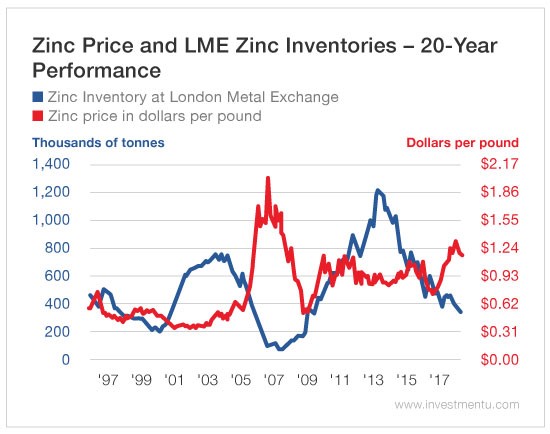
“Zinc doesn’t usually grab a lot of headlines,” I remarked late last year, “but it might start grabbing a few in 2017.”
The conditions continue to fall into place for a big rally in this overlooked metal. That’s why I believe zinc will be one of the hot commodities of this year.
As this week’s chart shows, zinc inventories at the London Metal Exchange (LME) have dropped to their lowest level since 2009. And as this chart also shows, periods of falling inventories tend to coincide with periods of rising zinc prices.
That’s not surprising. It’s common for a commodity’s price to rise whenever supplies of that commodity become relatively scarce. For example, when LME zinc inventories dropped sharply between 2004 and 2006, the zinc price quadrupled from $0.50 a pound to $2 a pound!
If zinc inventories continue sliding lower, the price will awaken from its slumber and make a move higher.
And today, falling inventories aren’t merely a possibility; they are the path of least resistance. That’s because the mine supply of zinc is trailing behind demand. And this “supply deficit” is likely to persist for several more years.
That deficit isn’t the result of just meager mine supplies. It’s also the result of robust demand.
Most of us pay zero attention to zinc, but the stuff is an essential aspect of our day-to-day lives. It is the world’s fourth-most used metal, behind iron, aluminum and copper.
Zinc combines with certain metals to make a wide variety of alloys. But its primary industrial use is to galvanize steel. Because of this connection with steel, zinc demand tracks global economic growth very closely, especially the construction-intensive economic growth that occurs in China.
In a TV interview late last year, Don Lindsay, the CEO of zinc major Teck Resources Ltd B (NYSE:TECK), declared, “We actually think the most exciting commodity is zinc because it has already gone through its bottoming process and is in a distinct [supply] deficit... [So] we think zinc is just on the verge of [a] big move.”
Lindsay believes the falling LME inventories, combined with falling mine production of zinc, will create a “pinch point sometime between now and six months from now.” At that point, he says, “We’ll see quite a move.”
How big could “quite a move” be? Here’s some food for thought...
If the zinc price regained its 2006 high of $2.11 per pound, that would be a gain of 79% from the current quote of $1.18 per pound.
Keep your eyes on zinc. This dull industrial metal may soon begin shining more brightly than gold or silver.
